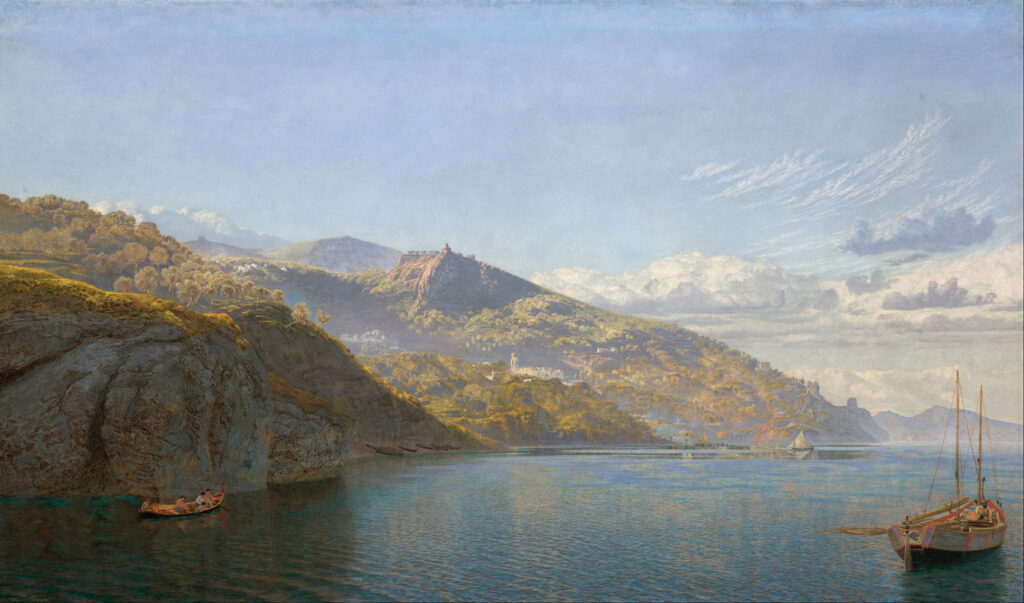Pre-Raphaelite landscapes of John Brett: 1 Travels

By about 1862, most artists had abandoned trying to paint Pre-Raphaelite landscapes because of their impossible demands. To conform to the prescriptions of critic John Ruskin required long weeks painting painstaking details of a view in front of the motif, and an independent income. The only artist who proved able to sustain this was John Brett (1831–1902), who continued to produce paintings conforming to Ruskin’s ideals and keeping the same ‘look’ until at least 1870. This weekend’s two articles look at those exceptional landscapes, and how they changed later.
Brett was a relative latecomer to the Pre-Raphaelite circle. Although he and his older sister Rosa started painting professionally from about 1850, John Brett wasn’t admitted to the Royal Academy Schools for training until early 1853, by which time the Pre-Raphaelite Brotherhood was dissolving. When in London, he made contact with artists of the Pre-Raphaelite movement, and discussed their art and techniques with Holman Hunt in particular. He read Ruskin, and admired the paintings of John Constable.
After painting portraits to bring in some income, he went to Switzerland in the summer of 1856, where he ascended to the glacier above the village of Rosenlaui, and painted his first real landscape work.
John Brett (1831–1902), Glacier of Rosenlaui (1856), oil on canvas, 44.5 x 41.9 cm, The Tate Gallery (Purchased 1946), London. © The Tate Gallery and Photographic Rights © Tate (2016), CC-BY-NC-ND 3.0 (Unported), http://www.tate.org.uk/art/artworks/brett-glacier-of-rosenlaui-n05643
Glacier of Rosenlaui (1856) is an extraordinarily accomplished first landscape painting. Influenced by the fourth volume of Ruskin’s Modern Painters, and the nearby work of John William Inchbold, who was painting about ten kilometres away at the time, it appears to have been painted entirely en plein air, in front of the glacier. Despite its great detail, particularly in the foreground, as prescribed by Ruskin, he signed and dated it 23 August 1856.
He also painted a few impressive watercolours before returning to England. In December, this painting had impressed Dante Gabriel Rossetti and Holman Hunt, and had even received praise from Ruskin himself. But the painting didn’t sell.
The following summer, Brett started work on a less technically-challenging and hopefully more marketable painting, which was possibly inspired by Gustave Courbet’s now-lost painting of stonebreakers, first shown in 1851.
John Brett (1831–1902), The Stonebreaker (1857-58), oil on canvas, 51.5 x 68.5 cm, Walker Art Gallery, Liverpool, England. Wikimedia Commons.
The Stonebreaker (1857-58) was painted closer to home, at a popular beauty spot in the south of England, near Box Hill, which dominates the distance. The milestone at the left shows the distance to London as 23 miles, and David Cordingly considers this places it along a historic track known as Druid’s Walk, leading from the Pilgrim’s Way over the Leatherhead Downs to Epsom and London.
This time, perhaps following his experience in Switzerland, Brett made extensive sketches and studies of the motif, worked on the final oil painting for at least twenty days en plein air, but then completed it in the studio during the following autumn and winter. The painting was shown at the Royal Academy in 1858, where it aroused considerable critical interest.
In the summer of 1858, Brett set off again to the Alps, where he ended up painting a second remarkable mountain view, this time at Val d’Aosta in north-west Italy.
John Brett (1831–1902), Val d’Aosta (1858), oil on canvas, 87.6 x 68 cm, Private collection. Wikimedia Commons.
Val d’Aosta (1858) was painted from a hill about a kilometre north-east of where Brett was lodging, according to Christopher Newall. In contrast to Glacier of Rosenlaui, Brett augments the geological details in the foreground with a sleeping woman and a brilliant white goat. Surprisingly, it omits the fortress of Châtel Argent and the Château de Saint-Pierre, although they appear in sketches he made at the time. The only buildings shown are smaller rustic farms and dwellings, set among finely detailed orchards, vineyards, and pastures.
Probably started in a series of studies and sketches, Brett seems to have worked on the oil version in front of the motif, then brought it back to England for completion during the late autumn of that year. He considered it finished by Christmas, and it was exhibited at the Royal Academy in 1859. Ruskin’s remarks were uncommitted, and the artist wasn’t made a single offer for its purchase.
Brett then tried for success with figurative and genre painting, and it wasn’t until 1861 that he returned to attempt any more proper Pre-Raphaelite landscapes. He first visited Florence in November 1861, and a year later left England to work on his next major work, a view encompassing almost the whole of the city that had been the cradle of much of the southern Renaissance.
John Brett (1831–1902), Florence from Bellosguardo (1863), oil on canvas, 60 x 101.3 cm, The Tate Gallery (Presented by Thomas Stainton in memory of Charles and Lavinia Handley-Read 1972), London. © The Tate Gallery and Photographic Rights © Tate (2016), CC-BY-NC-ND 3.0 (Unported), http://www.tate.org.uk/art/artworks/brett-florence-from-bellosguardo-t01560
He probably started on Florence from Bellosguardo (1863) in January 1863, and painted without the aid of significant preparatory studies, working entirely from the motif. Even with Brett’s apparent eye for fine detail at a distance, much of it must have been painted with the aid of a telescope, and it has been suggested that he may also have used a camera lucida and/or photographs. Regardless of how he managed to paint such great detail, it’s a triumph of painting, both technically and artistically, and it came as a shock when it was rejected by the Royal Academy in 1863.
Thankfully for Brett, the painting was purchased in May that year by the National Gallery, and he was acclaimed in the press as “head of the Pre-Raphaelite landscape school”, although by that time he must have been the last of its practitioners. Brett had also intended the painting as homage to the Brownings, as he had enjoyed the support of Robert Browning through that difficult period.
Brett didn’t hang around in England after this, but later that summer was back in Italy working again.
John Brett (1831–1902), Near Sorrento (1863), watercolour and bodycolour on paper, 24.9 x 33.4 cm, Birmingham Museum and Art Gallery, Birmingham, England.
Near Sorrento (1863) is a watercolour that Christopher Newall believes to have been painted from the Via del Capo, and shows the coastline at least five kilometres from that point, making it almost certain that its fine foreground detail was painted with the aid of a telescope. It still conforms to the basic requirements of a Pre-Raphaelite landscape, with fine detail, bright colours, and its careful rendering of geology.
John Brett (1831–1902), Massa, Bay of Naples (1863-64), oil on canvas, 63.8 x 102 cm, Indianapolis Museum of Art, Indianapolis, IN. Wikimedia Commons.
Massa, Bay of Naples (1863-64) is perhaps the most spectacular of the oil paintings Brett completed during this Mediterranean campaign, and appears to have been painted from a vessel on the water.
John Brett (1831–1902), Massa, Bay of Naples (detail) (1863-64), oil on canvas, 63.8 x 102 cm, Indianapolis Museum of Art, Indianapolis, IN. Wikimedia Commons.
He had travelled there on board the SS Scotia, although it’s unclear whether that ship served as his floating studio, or he transferred to another vessel. The Scotia arrived in the Bay of Naples by 9 September, following which he went to stay in Sorrento, then on to Capri by November. It’s therefore probable that he continued to work on this canvas during the following winter.
To his delight, Alfred Morrison bought this painting on 6 May 1864, for the substantial sum of £250, although Morrison may actually have paid in guineas. Brett was to benefit further from Morrison’s generous patronage, and by August in 1865 could afford to buy his own yacht. That enabled him to concentrate on painting in British waters.
John Brett (1831–1902), February in the Isle of Wight (1866), watercolour, bodycolour and gum on paper, 46 x 35.4 cm, Birmingham Museum and Art Gallery, Birmingham, England. Wikimedia Commons.
During the winter of 1865-66, Morrison remained on or near the Isle of Wight, where Brett’s new boat had been built. He painted two watercolour landscapes of the Island, of which only February in the Isle of Wight (1866) has been traced. Although a superb painting, its style is starting to drift away from the principles laid down by the Pre-Raphaelites.
References
Barringer T (2012) Reading the Pre-Raphaelites, revised edn, Yale UP. ISBN 978 0 300 17733 6.
Cordingly D (1982) ‘The Stonebreaker’: an examination of the landscape in a painting by John Brett, Burlington Mag. 129, March 1982, pp 141-145.
Newall C (2007) ‘Val d’Aosta’: John Brett and John Ruskin in the Alps, 1858, Burlington Mag. 149, March 2007, pp 165-172.
Newall C (2012) Review of Payne (2010), Burlington Mag. 154, July 2012, pp 498-499.
Payne C (2010) John Brett: Pre-Raphaelite Landscape Painter, Yale UP. ISBN 978 0 300 16575 3.
Prettejohn E (2000) The Art of the Pre-Raphaelites, Tate Publishing. ISBN 978 1 854 37726 5.
Staley A (2001) The Pre-Raphaelite Landscape, 2nd edn, Yale UP. ISBN 978 0 300 08408 5.



